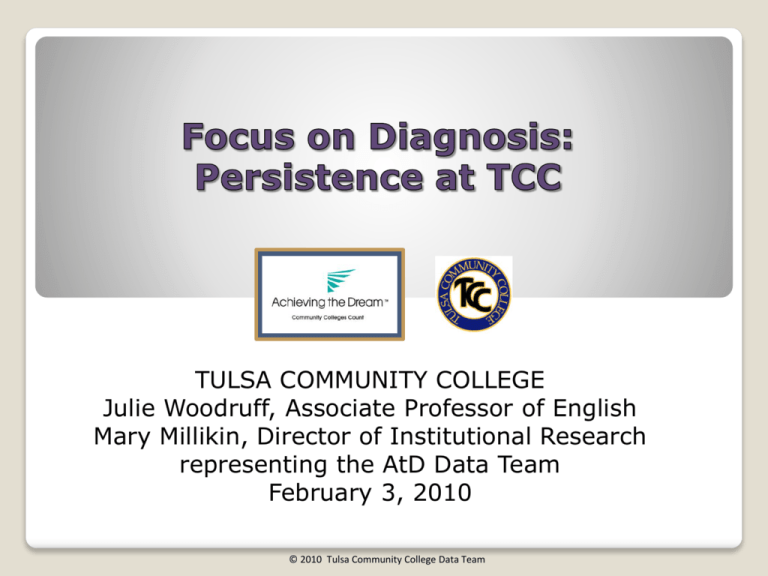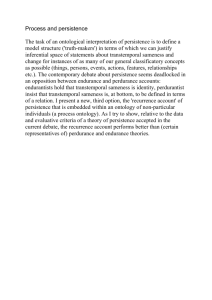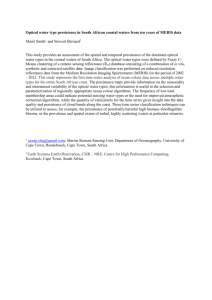Overcoming the Challenges of Developmental Reading
advertisement

TULSA COMMUNITY COLLEGE Julie Woodruff, Associate Professor of English Mary Millikin, Director of Institutional Research representing the AtD Data Team February 3, 2010 © 2010 Tulsa Community College Data Team TCC Fall 2009 Profile 19,198 students Four campuses city-wide 62% female and 38% male 26% minority students 3,531 first-time freshmen 44% of students under age 74% university parallel 21 What’s Wrong? Why? Intervention Assessment and Modification •Institutional Research conducted a comprehensive analysis of student success disaggregated by demographics •Core Team selected three priorities for further analysis over next four years Persistence Rate Persist or Graduate 100 80 60 40 20 0 100% 75% 50% 49% 1972 1485 989 968 40% 781 36% 717 Graduation Rate by Reading Placement 1404 263 305 Graduation Rate By Math Placement 648 48 143 1133 YEAR PRIORITY 2008-09 First-time Freshmen Persistence 2009-10 Developmental Reading 2010-11 Developmental Mathematics African-American Male Student Persistence What’s wrong? • 75% of students do not persist from fall to spring semester • 50% of students do not persist from fall to fall semester Why? Intervention Assessment and Modification •Student focus groups •Faculty and staff focus groups •Literature review Focus Group Preparation Planning Recruiting students Ordering supplies Student Focus Group Participants 12 student focus groups 3 focus groups at each of 4 campuses 101 students Student participants in focus groups matched demographics of students in first-time freshmen cohort Student Results Most Frequent Barriers Adjusting to college Balancing school, employment, and life Difficulty choosing courses Communication issues with instructors Textbook issues Persistence Findings Service Barriers Academic Barriers Adjustment Barriers 82% of all barriers fell into one of 3 major types or clusters. Faculty and Staff Results Faculty and Staff Focus Groups 2 focus groups offered per campus* 7 total groups conducted 64 total participants; 25 faculty and 39 staff First groups on each campus were mixed groups of faculty and staff volunteers. The second focus groups on each campus contained only faculty. Asked faculty and staff what challenges they experience in helping students persist to their 2nd semester. *One campus filled one focus group; the second group on that campus was not attended. Most Frequent Faculty/Staff Obstacles Student attitudes/motivation Students not academically prepared Textbooks Part-time instruction issues Online courses Advisement-related issues Financial Aid Persistence Findings: Clusters Policies & Administrative Practices Instruction Student Attitudes & Motivation 76% of all barriers fell into one of 3 major types or clusters. What’s Wrong? Why? • Students: Adjusting to college; Balancing school, employment and life, and others • Faculty: Student under-preparation and motivation; college policies, and others Intervention Assessment and Modification From student and faculty barriers: Strategies for Academic Success course Strategies for Academic Success Intervention: Design Hiring Criteria Assessments Enrollment Limits Training Course Objectives Textbook Strategies for Academic Success Intervention: Support Faculty Support Website on Blackboard Campus Lead Instructors Textbook Author Presentation to TCC Faculty Strategies for Academic Success Intervention: Organization and Structure Strategies for Academic Success Intervention Team Leader ◦ Responsibilities ◦ Compensation Strategies for Academic Success Intervention Team ◦ Responsibilities ◦ Membership and Structure Strategies for Academic Success Intervention: Organization and Structure cont’d Campus Lead Instructors ◦ Responsibilities Faculty (full-time employees of the college preferred) ◦ Responsibilities ◦ Compensation Strategies for Academic Success Intervention: Focus Groups Reveal Most Frequent Challenges for Lead Faculty Time required to update faculty support site Getting faculty to read and use available online support resources in Blackboard Number of faculty to mentor Dependence of some faculty on lead faculty for many lesson plans and activities Strategies for Academic Success Intervention: Focus Groups Reveal Most Frequent Challenges for Faculty Course Planning, Preparation, Delivery Academically Unprepared Students Scheduling Student Support Services Instructor Collaboration Strategies for Academic Success Intervention: Formative Assessment of Training Training Survey: Content, Needs, Timing, Satisfaction Results to Intervention Team Strategies for Academic Success Intervention: Changes Improved instructor directions for administering LASSI (Learning and Study Strategies Inventory) Improved in-house online collection tools for instructors’ assessment data Strategies for Academic Success Intervention: Next Steps Common Cognitive Assessment ◦ Complete pilot ◦ Implement Fall 2010 Based on Training Survey, review training and modify, if needed Evaluate Strategies for Academic Success course •Student results •Faculty feedback •Lead faculty feedback Student Results Strategies for Academic Success (ENGL 1003) and College Survival (ENGL 0903) Year 1: 2008-2009 ◦ 61 sections fall 2008 ◦ 42 sections spring 2009 ◦ 14 sections summer 2009 Groups for comparison from Fall 2008 firsttime freshman cohort ◦ Enrolled in Strategies (1,712) ◦ Enrolled in College Survival (92) ◦ Enrolled in neither course (1,851) Fall-to-Spring Persistence 100% 80% 85% 66% 60% 59% 40% 20% 0% Strategies *Significant at alpha < .01 Survival Neither Fall-to-Spring Persistence for Highest At-risk Students 100% 80% 66% 60% 55% 40% 20% 0% Survival *Significant at alpha < .01 Reading I Non-Survival Fall-to-Fall Persistence 100% 80% 60% 61% 40% 39% 41% 20% 0% Strategies *Significant at alpha < .01 Survival Neither Fall-to-Fall Retention for the Most At-risk Students 100% 80% 60% 40% 39% 37% 20% 0% Survival *Not significant at alpha < .01 Reading I Non-Survival Significant Differences in Course Grades Between Strategies and Non-Strategies Students in Basic Math Writing II (Developmental Writing) College Algebra Biology for Majors US History 1492 to Civil War Era Introduction to Psychology *Significant at alpha < .01 Persistence Intervention African-American Male Student Intervention African-American Male Student: Component 1 -- What’s Wrong? Fall-to-Spring Persistence = 60% 75% overall first-time freshmen Fall-to-Fall Persistence = 36% 50% overall first-time freshmen Persistence after three years, including graduation = 16% 36% overall first-time freshmen persistence after three years (graduation or retention) African-American Male Student: Component 2 -- Why? 7 student focus groups Facilitators and scribes: African-American male TCC employees Challenges with recruiting participants Data analysis in process African-American Male Student: Focus Group Preliminary Themes ◦ Difficulty balancing school, employment, and life ◦ Needing academic and career goals ◦ Experiencing self-defeating attitudes and low motivation ◦ Having insufficient academic preparation ◦ Experiencing stereotyping ◦ Wanting to see more AA male mentors, AA role models, AA male students on campus African-American Male Student: Next Steps in Component 2--Why? Additional focus groups to be conducted with general faculty and general staff on all campuses Research Question: “What are your challenges/obstacles in assisting AfricanAmerican male students to persist at TCC?” African-American Male Student Next Steps cont’d: Component 3--Intervention ◦ Receive student focus group data ◦ Digest focus group data, literature reviews, interviews ◦ Design intervention and assessment MarchJuly ◦ Implement intervention Fall 2010 African-American Male Student Intervention: Next Steps cont’d Component 4-- Assessment and Modification ◦ Assess intervention formatively and summatively ◦ Based on assessment data, modify intervention to increase effectiveness







